Dam Construction
How to make the concrete that would keep the river from its destructive course;
how to build mixing plants close to the project when the formidable geology of the
cliffs seemed to prohibit installation of any substantial proportion; how to supply
aggregate to the concrete mixers in exact quantity and size for four years running;
how to mix the ingredients together with more efficiency and speed than anyone had
ever seen before; how to deliver the mix to the building site without it setting and
having to be chipped out by hand, piece by piece, with a hammer and chisel; these were
a few of the problems facing the government engineers."
from And the Desert Shall Blossom
by Phyllis Barber
How is a concrete dam constructed?
Materials
Diversion
Foundation
Forms
Pouring
Insulation
Additional structures
Maintenance
|
Materials
Where will the materials for the project come from? For
concrete, you need water, aggregate (rock), and cement. And you need to be able
to mix it all up in the right proportions.
The aggregate is often taken from the dam site itself, if rock had to be blasted for the
foundation. A concrete mixing plant is built near the site for large projects. |
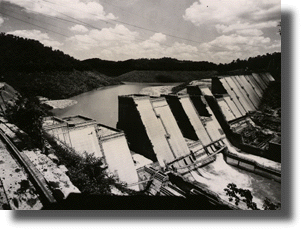 |
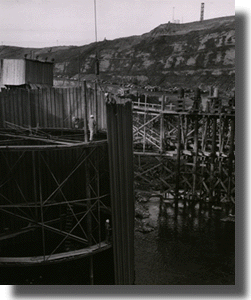 |
Diversion
The water must be diverted from its normal course in order to build the dam.
This can be done several ways. Sometimes tunnels are dug into the abutments and the
water is sent through the tunnels. In other cases, a cofferdam (a temporary dam built
to keep an area dry) is constructed around the site. The image to the left is a
cofferdam built during the construction of the Chief Joseph Dam on the Columbia
River in Washington state. |
|
back to top |
Foundation
The foundation must be stable and solid. Bedrock is best. Sometimes the workers
must blast the foundation to get to a solid, level surface. Holes or cracks in
the foundation can be filled in with grout (cement-like material). After the dam
is built, there must be some provision for drainage of the foundation so that there
is no uplift pressure on the dam. |
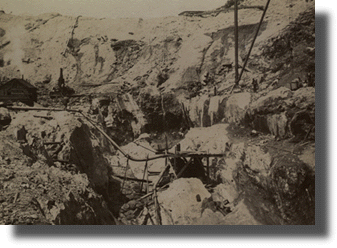 |
|
back to top |
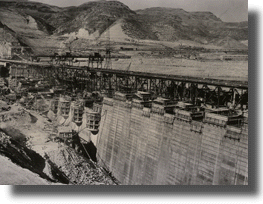 |
Forms
Large concrete dams are built in sections, usually square or rectangular blocks that are open at the top.
The size of the blocks is determined by things like how big the dam is or
how far the concrete must travel to get there. The blocks, called formwwork, can
be built from wood or steel. Wood is initially cheaper but can only be reused about half a
dozen times. Steel is initially more expensive, but it is much more reusable.
Several sections of the formwork are usually built at a time. Once the concrete
hardens, the formwork can be removed and rebuilt for the next section of the dam. |
Pouring the concrete
Concrete must be mixed at a mixing plant, either on-site or off the site, and then
transported to the formwork and poured into it. The concrete can be transported
by overhead cable, as in the picture. As it is poured into the formwork, men or
machines make sure it fills the forms evenly. The concrete gets hot as it hardens, so
sometimes a cooling system is built into the dam. Pipes with very cold water might
run through the dam to help combat the heat. |
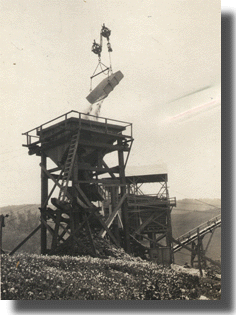 |
|
back to top |
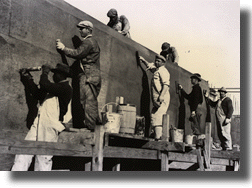 |
Insulation
After all of the concrete has been poured and the formwork removed, a finish is
often applied. The finish might be a thin layer of concrete or some other
commercial product. The finish both protects the dam from premature
weathering and makes the dam more aestheically pleasing for the
public. |
Additional structures
There may be additional structures to the main dam. A spillway might be built to
release excess water from the reservoir -- it is basically a path for the water
to go around the dam. Outlet works can also be built to regulate the release of water
from the dam. If the dam is to create hydroelectric power, the power plant must
be built. To the right are the turbines on Dam No. 25 on
the Mississippi River in Missouri. |
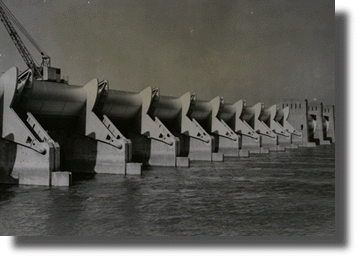 |
|
back to top |
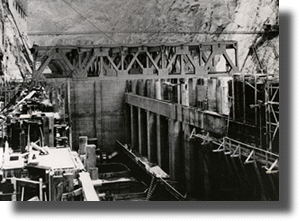 |
Maintenance
After a dam is constructed and in use, it must be monitered closely to ensure
that cracking, leakage, and erosion are kept to a minimum. Without careful
monitoring and consequently maintaining a dam, a preventable catastrophe
may result. Photo: power plant at Hoover Dam. |
|
back to top
 Each of these steps are performed or overseen by
engineers, often civil engineers! Each of these steps are performed or overseen by
engineers, often civil engineers!
|


|


